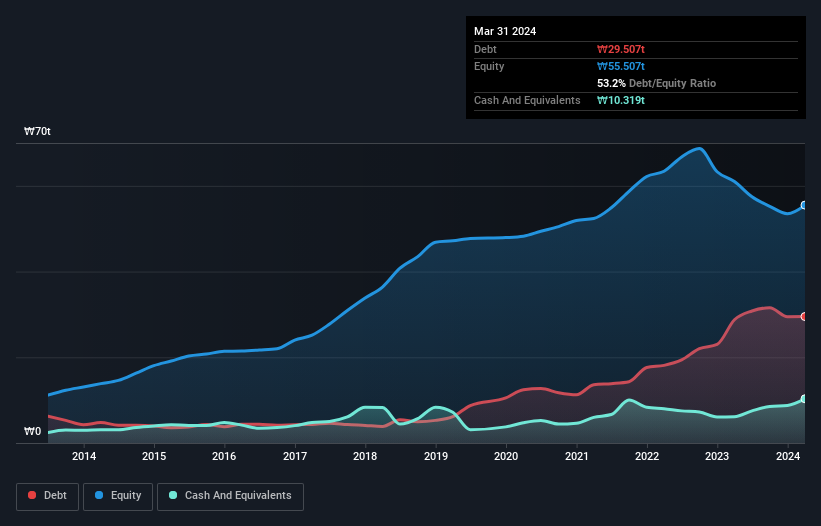The external fund manager backed by Berkshire Hathaway's Charlie Munger, Li Lu, makes no bones about it when he says 'The biggest investment risk is not the volatility of prices, but whether you will suffer a permanent loss of capital.' It's only natural to consider a company's balance sheet when you examine how risky it is, since debt is often involved when a business collapses. Importantly, SK hynix Inc. (KRX:000660) does carry debt. But is this debt a concern to shareholders?
When Is Debt Dangerous?
Debt and other liabilities become risky for a business when it cannot easily fulfill those obligations, either with free cash flow or by raising capital at an attractive price. Ultimately, if the company can't fulfill its legal obligations to repay debt, shareholders could walk away with nothing. However, a more frequent (but still costly) occurrence is where a company must issue shares at bargain-basement prices, permanently diluting shareholders, just to shore up its balance sheet. Of course, debt can be an important tool in businesses, particularly capital heavy businesses. When we think about a company's use of debt, we first look at cash and debt together.
Check out our latest analysis for SK hynix
What Is SK hynix's Debt?
As you can see below, SK hynix had ₩30t of debt, at March 2024, which is about the same as the year before. You can click the chart for greater detail. However, it does have ₩10t in cash offsetting this, leading to net debt of about ₩19t.

A Look At SK hynix's Liabilities
We can see from the most recent balance sheet that SK hynix had liabilities of ₩11t falling due within a year, and liabilities of ₩37t due beyond that. On the other hand, it had cash of ₩10t and ₩7.18t worth of receivables due within a year. So it has liabilities totalling ₩30t more than its cash and near-term receivables, combined.
This deficit isn't so bad because SK hynix is worth a massive ₩121t, and thus could probably raise enough capital to shore up its balance sheet, if the need arose. However, it is still worthwhile taking a close look at its ability to pay off debt. When analysing debt levels, the balance sheet is the obvious place to start. But ultimately the future profitability of the business will decide if SK hynix can strengthen its balance sheet over time. So if you want to see what the professionals think, you might find this free report on analyst profit forecasts to be interesting.
In the last year SK hynix wasn't profitable at an EBIT level, but managed to grow its revenue by 6.8%, to ₩40t. That rate of growth is a bit slow for our taste, but it takes all types to make a world.
Caveat Emptor
Importantly, SK hynix had an earnings before interest and tax (EBIT) loss over the last year. To be specific the EBIT loss came in at ₩1.4t. Considering that alongside the liabilities mentioned above does not give us much confidence that company should be using so much debt. So we think its balance sheet is a little strained, though not beyond repair. We would feel better if it turned its trailing twelve month loss of ₩4.6t into a profit. So we do think this stock is quite risky. When we look at a riskier company, we like to check how their profits (or losses) are trending over time. Today, we're providing readers this interactive graph showing how SK hynix's profit, revenue, and operating cashflow have changed over the last few years.
If you're interested in investing in businesses that can grow profits without the burden of debt, then check out this free list of growing businesses that have net cash on the balance sheet.
New: Manage All Your Stock Portfolios in One Place
We've created the ultimate portfolio companion for stock investors, and it's free.
• Connect an unlimited number of Portfolios and see your total in one currency
• Be alerted to new Warning Signs or Risks via email or mobile
• Track the Fair Value of your stocks
Have feedback on this article? Concerned about the content? Get in touch with us directly. Alternatively, email editorial-team (at) simplywallst.com.
This article by Simply Wall St is general in nature. We provide commentary based on historical data and analyst forecasts only using an unbiased methodology and our articles are not intended to be financial advice. It does not constitute a recommendation to buy or sell any stock, and does not take account of your objectives, or your financial situation. We aim to bring you long-term focused analysis driven by fundamental data. Note that our analysis may not factor in the latest price-sensitive company announcements or qualitative material. Simply Wall St has no position in any stocks mentioned.
About KOSE:A000660
SK hynix
Manufactures, distributes, and sells semiconductor products in Korea, China, rest of Asia, the United States, and Europe.
Outstanding track record and undervalued.
Similar Companies
Market Insights
Community Narratives



